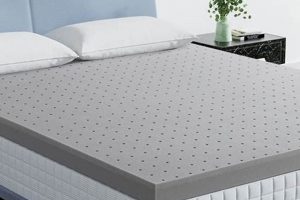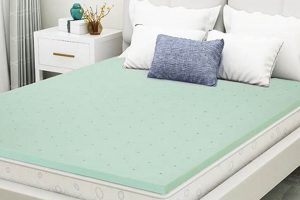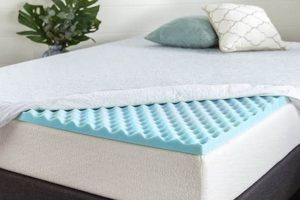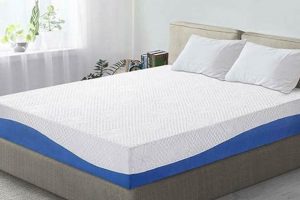The necessity of a box spring for use with a memory foam mattress is a common inquiry. A box spring traditionally serves to elevate a mattress, provide support, and absorb shock, thereby extending the mattress’s lifespan. However, the compatibility of a memory foam mattress with a box spring depends on several factors, primarily the support requirements of the mattress and the condition of the existing support structure.
Proper support is critical for the longevity and performance of a memory foam mattress. Lack of adequate support can lead to premature sagging, voiding the warranty, and diminishing the comfort provided by the mattress. Historically, box springs were universally recommended for innerspring mattresses to distribute weight and prevent wear. However, advancements in mattress design and alternative support systems have broadened the options available to consumers.
This discussion will delve into the types of support systems suitable for memory foam mattresses, focusing on how to determine if a box spring is necessary or if alternative platforms, such as solid platforms or slatted frames, provide sufficient support and meet warranty requirements.
Support System Selection for Memory Foam Mattresses
Selecting the appropriate support structure is crucial for optimizing the comfort and lifespan of a memory foam mattress. The following considerations will aid in determining the most suitable foundation.
Tip 1: Consult the Mattress Warranty: Review the manufacturer’s warranty requirements regarding acceptable support systems. Failure to comply may void the warranty.
Tip 2: Assess the Existing Box Spring’s Condition: If utilizing an existing box spring, inspect it for sagging, broken slats, or compromised support. A damaged box spring will not provide adequate support and may damage the mattress.
Tip 3: Consider a Solid Platform Base: A solid platform bed provides uniform, rigid support, which is often ideal for memory foam mattresses. Ensure the platform is constructed of durable materials and can bear the combined weight of the mattress and sleepers.
Tip 4: Evaluate Slatted Foundations: If using a slatted foundation, ensure the slats are closely spaced (typically no more than 2-3 inches apart) to prevent sagging. The slats should also be sufficiently thick and strong.
Tip 5: Avoid Flexible Box Springs: Traditional box springs with coils are generally not recommended for memory foam mattresses, as they can create uneven support and reduce the mattress’s lifespan.
Tip 6: Account for Weight Distribution: Consider the weight capacity of the chosen support system. Overloading the foundation can lead to structural failure and damage to the mattress.
Tip 7: Prioritize Breathability: Some support systems, such as slatted foundations, promote airflow around the mattress, which can help regulate temperature and prevent moisture buildup.
Selecting the correct support system enhances the functionality and longevity of a memory foam mattress, ensuring optimal sleep quality and preserving the investment.
The subsequent sections will address alternative support options and factors influencing the ultimate decision.
1. Warranty Requirements
Warranty stipulations represent a crucial determinant when evaluating the necessity of a box spring for a memory foam mattress. Manufacturers often specify acceptable support systems, and non-compliance can lead to warranty invalidation, rendering the consumer liable for repair or replacement costs associated with premature mattress degradation.
- Foundation Type Specifications
Mattress warranties frequently enumerate acceptable foundation types, such as solid platforms, slatted frames with specific spacing requirements, or traditional box springs. Some manufacturers may explicitly prohibit the use of box springs with internal coils, particularly those lacking adequate rigidity. Failure to adhere to these stipulations can void the warranty, even if the mattress defect is seemingly unrelated to the foundation.
- Support Structure Dimensions
Warranties may also dictate minimum dimensional requirements for the support structure, including slat thickness, slat spacing, and overall frame height. Insufficient support can lead to mattress sagging or uneven wear, which may not be covered under warranty if the foundation fails to meet the specified criteria. For example, a warranty might require slats to be no more than 2 inches apart to prevent indentation or compression of the memory foam layers.
- Weight Capacity Limitations
Weight capacity limitations are frequently outlined in mattress warranties, particularly for heavier mattresses or those designed for multiple sleepers. Exceeding the foundation’s weight capacity can result in structural damage, which, in turn, can damage the mattress. Damage resulting from exceeding weight limits is generally not covered under warranty, emphasizing the importance of selecting a support system with adequate load-bearing capabilities.
- Documentation of Support System
In some instances, manufacturers may require proof of purchase or specifications for the support system used with the mattress. This documentation serves to verify compliance with warranty requirements in the event of a claim. Retaining records of the foundation’s purchase and specifications can be crucial for substantiating a warranty claim related to mattress defects or premature wear.
Compliance with warranty requirements is not merely a formality; it’s a safeguard against potential financial losses resulting from premature mattress failure. Careful consideration of warranty specifications pertaining to support systems is essential for ensuring both the longevity of the memory foam mattress and the validity of its warranty coverage. Failing to align the support system with the specified requirements can lead to costly repercussions down the line.
2. Support System Types
The relationship between the types of support systems employed and the necessity of a box spring for a memory foam mattress is direct and consequential. The support system directly influences the mattress’s lifespan, comfort, and compliance with warranty stipulations. Different foundations exert varying effects on a memory foam mattress’s performance, negating or reinforcing the requirement for a traditional box spring.
Solid platform beds, for example, offer a uniform, rigid surface. This construction often renders a box spring superfluous, as the platform itself provides ample support and prevents sagging. Conversely, a slatted foundation might necessitate a box spring, depending on the slat spacing and mater
ial strength. If the slats are widely spaced or constructed of weak materials, they may not provide sufficient support, leading to uneven weight distribution and potential mattress damage. In such cases, a box spring can serve as an intermediary layer, enhancing support and prolonging the mattress’s life. Adjustable bases represent another support type, offering customized positioning. While providing unique features, they inherently negate the need for a box spring due to their integrated support structure. The choice of support system, therefore, becomes a critical determinant in assessing whether a box spring is required.
In summary, the diverse range of support system types dictates the necessity of a box spring for a memory foam mattress. Solid platforms and adjustable bases typically obviate the need for a box spring, while slatted foundations require careful evaluation to determine if additional support is necessary. Understanding the specific characteristics of each support system type is paramount in ensuring optimal mattress performance and adherence to warranty requirements.
3. Platform Bed Suitability
Platform bed suitability is a primary factor influencing whether a memory foam mattress requires a box spring. Platform beds are designed with an integrated support system, often consisting of a solid surface or closely spaced slats. This inherent support structure frequently eliminates the necessity for a supplementary box spring, provided the platform is appropriately constructed and maintained. The cause-and-effect relationship is clear: a well-designed platform bed provides adequate support, negating the need for additional reinforcement from a box spring. The importance of platform bed suitability lies in its ability to directly support the mattress, distributing weight evenly and preventing premature sagging. For example, a platform bed with poorly spaced slats can create pressure points, leading to uneven wear and potential damage to the memory foam. Thus, understanding the construction and integrity of the platform is critical.
Furthermore, the material and design of the platform bed frame significantly impact its suitability. A platform constructed from solid wood or metal offers greater structural integrity and weight-bearing capacity compared to those made from particleboard or flimsy materials. The absence of a need for a box spring translates to a lower overall bed height, a factor that is aesthetically desirable for many. However, one must consider whether the reduced height is suitable for individual needs, as a lower bed frame can present challenges for individuals with mobility issues. Some platform beds also incorporate storage drawers beneath the mattress, a feature that further integrates the bed’s functionality, eliminating the space typically occupied by a box spring.
In summary, the suitability of a platform bed is a critical component in determining whether a memory foam mattress requires a box spring. When a platform bed provides adequate, even support, a box spring becomes redundant. Prioritizing platform beds constructed from durable materials and with appropriate slat spacing is crucial for maximizing mattress lifespan and comfort. Selecting a suitable platform bed presents a cost-effective and space-saving alternative to traditional bed frames with box springs, offering a streamlined and contemporary aesthetic.
4. Slatted Frame Spacing
The distance between slats in a bed frame significantly impacts the support provided to a memory foam mattress. Insufficient support can compromise the mattress’s integrity and void manufacturer warranties, making slat spacing a crucial factor in determining the necessity of a box spring.
- Excessive Gaps and Mattress Sagging
Wide gaps between slats (exceeding approximately 2-3 inches) create areas of inadequate support. This leads to localized sagging of the memory foam, particularly under areas of concentrated weight. The sagging can result in uneven sleep surfaces, discomfort, and premature degradation of the mattress’s internal structure. In such instances, a box spring or a solid platform becomes necessary to distribute weight more evenly and prevent sagging.
- Warranty Compliance and Support Requirements
Mattress manufacturers often specify maximum slat spacing in their warranty requirements. These specifications ensure the mattress receives adequate support, preventing structural damage. Slat spacing that exceeds the manufacturer’s recommendations can void the warranty, leaving the consumer responsible for repair or replacement costs. A box spring can provide the required support if the slatted frame alone does not meet warranty standards.
- Impact on Air Circulation and Moisture
While closer slat spacing provides better support, it can also impede air circulation. Adequate airflow is essential for preventing moisture buildup within the mattress, which can lead to mold growth and reduced lifespan. The trade-off between support and air circulation must be considered. A box spring, particularly one with an open structure, can enhance airflow while providing the necessary support if the slat spacing is relatively close.
- Slat Material and Weight Distribution
The material and thickness of the slats also influence their ability to provide support. Thin or flexible slats, even with minimal spacing, may not adequately distribute weight, leading to sagging. Sturdy, rigid slats are essential for proper support. A box spring can compensate for weaker slats by providing a more robust and evenly distributed support layer.
In conclusion, the spacing between slats directly affects the need for a box spring with a memory foam mattress. Excessive gaps, non-compliance with warranty requirements, inadequate air circulation, and weak slat materials all increase the likelihood that a box spring is necessary to ensure proper support, maintain warranty validity, and prolong the mattress’s lifespan.
5. Foundation Material Quality
The materials constituting a mattress foundation directly correlate with the necessity of a box spring for memory foam mattresses. Foundation material quality dictates the level of support and durability the base offers. A foundation crafted from inferior materials may lack the structural integrity to adequately support a memory foam mattress, leading to sagging and premature wear. For instance, a foundation constructed with low-grade wood or flimsy metal components can buckle under the mattress’s weight, creating uneven support and diminishing the mattress’s lifespan. This scenario underscores the importance of robust foundation materials, potentially negating the need for a box spring if the foundation itself offers sufficient support.
Conversely, foundations made from high-quality materials, such as solid hardwood or reinforced steel, provide a stable and reliable base. Such foundations distribute weight evenly, mitigating the risk of sagging and ensuring optimal comfort. This eliminates the need for a box spring, as the primary function of weight distribution and support is already fulfilled. Consider the example of a
solid platform bed made of kiln-dried hardwood, which offers a rigid and uniform surface. This eliminates the need for a box spring. Conversely, a slatted frame made from thin, flexible wood might require a box spring to provide additional support and prevent mattress deformation. The durability inherent in quality materials translates directly into long-term cost savings. A robust foundation is less prone to damage or degradation, reducing the likelihood of needing to replace the entire bed support system.
In summary, foundation material quality plays a pivotal role in determining if a memory foam mattress necessitates a box spring. High-quality materials offer enhanced support and durability, often rendering a box spring unnecessary. Conversely, inferior materials may require the addition of a box spring to compensate for the foundation’s lack of structural integrity. Choosing a foundation constructed from robust materials ensures the long-term performance and comfort of the memory foam mattress, potentially eliminating the additional expense of a box spring and contributing to a more sustainable and cost-effective sleep solution.
Frequently Asked Questions
This section addresses common inquiries regarding the necessity of a box spring for use with a memory foam mattress, providing clarity on factors influencing this decision.
Question 1: Is a box spring universally required for all memory foam mattresses?
No. The need for a box spring is contingent upon the specific mattress and the support system used. Solid platform beds or adequately spaced slatted frames may provide sufficient support, rendering a box spring unnecessary.
Question 2: Can using an old box spring damage a new memory foam mattress?
Yes. A deteriorated box spring with sagging coils or broken components can compromise the structural integrity of the mattress, leading to uneven support and premature wear.
Question 3: Will using a box spring automatically void the mattress warranty?
Not necessarily. However, it is crucial to consult the mattress manufacturer’s warranty documentation. Some warranties specify acceptable support systems, and non-compliance may invalidate the warranty.
Question 4: What are the alternatives to a traditional box spring for memory foam mattresses?
Viable alternatives include solid platform beds, slatted frames with appropriate slat spacing (typically no more than 2-3 inches apart), and adjustable bed bases. Each offers varying levels of support and functionality.
Question 5: How does weight distribution influence the need for a box spring?
Uneven weight distribution can accelerate mattress wear. If the existing support system does not adequately distribute weight, a box spring may be beneficial in providing additional support and prolonging the mattress’s lifespan.
Question 6: Does the thickness of a memory foam mattress affect the necessity of a box spring?
While thickness alone is not the sole determinant, thicker mattresses generally require more robust support. A thinner mattress might be adequately supported by a slatted frame, whereas a thicker mattress may benefit from the added support of a box spring or solid platform.
These FAQs highlight the nuanced relationship between memory foam mattresses and box springs. Evaluating the mattress type, warranty stipulations, and existing support system is essential for making an informed decision.
The following section will explore the implications of choosing the wrong support system for a memory foam mattress.
Concluding Thoughts
The preceding analysis clarifies the multifaceted relationship between support structures and memory foam mattresses. The question of whether a memory foam mattress requires a box spring is not a simple yes or no proposition. The answer hinges on several key factors: the mattress warranty stipulations, the type and condition of existing support structures, and the inherent support characteristics of alternative foundations like platform beds and slatted frames. Failure to account for these elements can compromise the mattress’s lifespan, diminish its comfort, and potentially void the manufacturer’s warranty.
Therefore, a thoughtful and informed assessment of individual needs and mattress specifications is paramount. Prioritizing proper support ensures the longevity and performance of the memory foam investment. Consumers are encouraged to meticulously review warranty requirements and consider the long-term implications of their support system choice, maximizing both comfort and value.




![Top Rated Best Memory Foam Mattress Brands [Year] Organic & Natural Mattress Buyer’s Guide: Non-Toxic Sleep Solutions Top Rated Best Memory Foam Mattress Brands [Year] | Organic & Natural Mattress Buyer’s Guide: Non-Toxic Sleep Solutions](https://mattressworldpa.com/wp-content/uploads/2025/07/th-4022-300x200.jpg)


